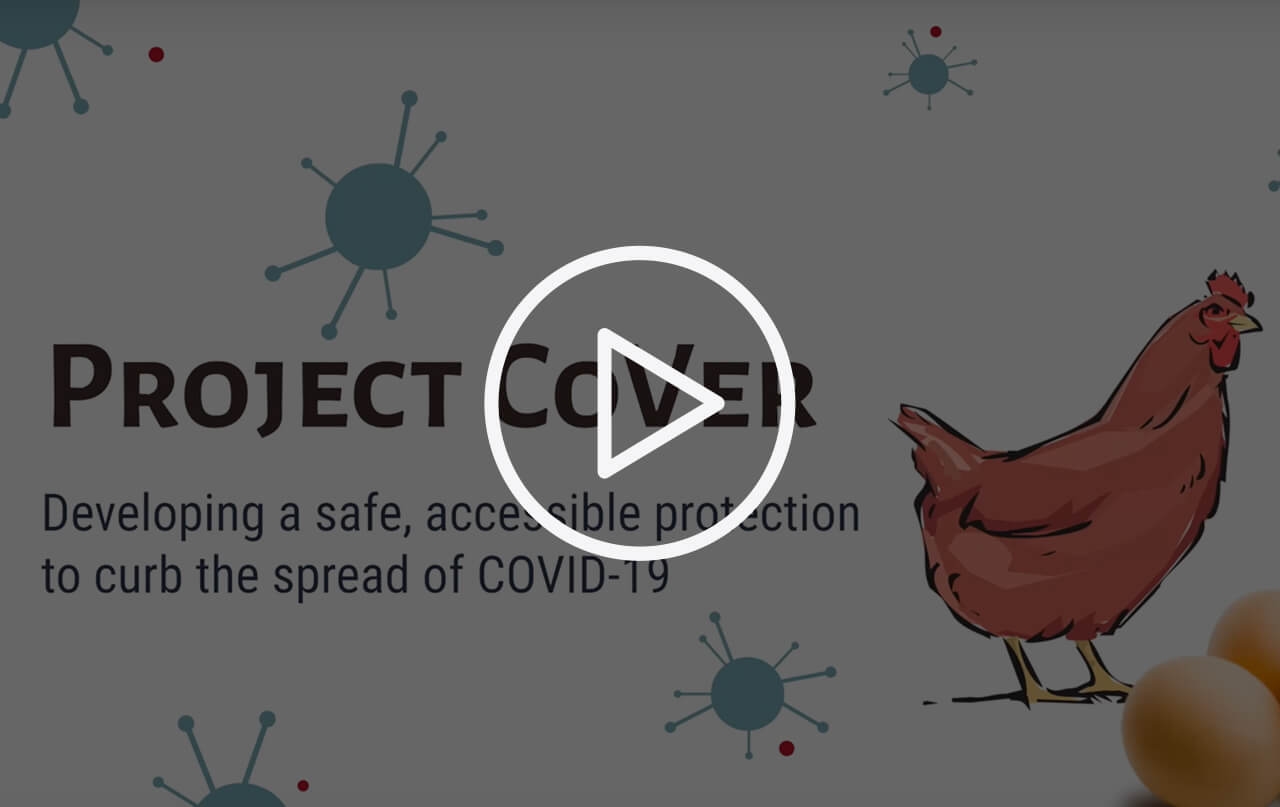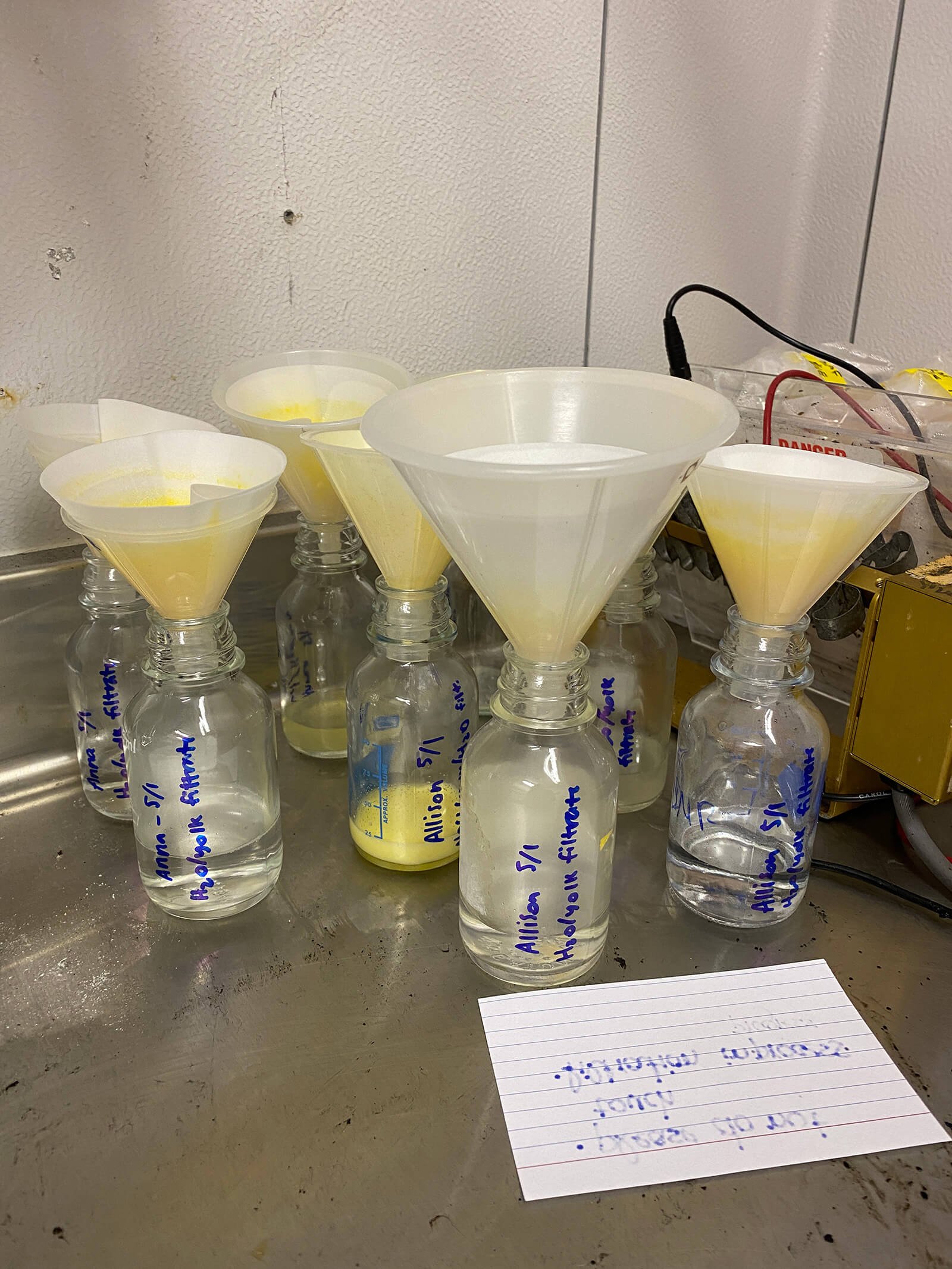Health Technology Showcase
Five Questions and an Elevator Pitch:
CoVer
 In this short video, the CoVer team explains the need they set out to address and how their solution works.
In this short video, the CoVer team explains the need they set out to address and how their solution works.
1. What it the need your project seeks to address?
Carrie: Globally, over 3 million people have died of COVID-19. While vaccines are available, they have some drawbacks. They are difficult to obtain worldwide, they take time to start working, they may be less effective for people who are immunocompromised, and they are slow to be adopted by people with vaccine hesitancy. We are developing an alternative treatment to prevent COVID-19 that overcomes these obstacles and is safe and accessible worldwide. Our protocol can also be modified for use in future pandemics.
2. How does your solution work?
Edward: The solution that we are working on is a prophylactic, intranasal drop made from an egg yolk -derived antibody called immunoglobulin Y or IgY. IgY doesn’t require the body to produce an immune response; instead it binds to receptors in the nasal passage and blocks the viral particles, preventing them from causing infection. We set out to develop a method of IgY purification that can be done without sophisticated lab equipment – so it will be accessible anywhere int the world.
Chris: To produce IgY, egg-laying hens are injected with the recombinant spike protein, which causes them to make antibodies. When they lay their eggs, the antibody is contained in the yolk. The eggs are collected and the IgY is extracted, purified, and packaged as a nasal drop. While the method to extract IgY can easily be completed in a state-of-the art laboratory, our team is adjusting the process so it can be done effectively in a low-resource setting using readily available materials like vinegar and salt, along with a food processor as a makeshift centrifuge.
 Filtering the egg yolk after the first round of acidification
Filtering the egg yolk after the first round of acidification
3. What motivated you to take-on the project and what activities have you undertaken?
Allison: In the beginning, we were just exploring ideas. There are four of us on the lab team, and our goal was to see whether we could acidify the egg yolk enough to extract the proteins. We were working in the dorm bathroom, cracking eggs and adding salt and vinegar, and testing with a home Ph meter. It seemed more like a middle school science project! But when we were finally able to get into the lab and run the experiments repeatedly, we started to see results. At that point, we got excited because it was clear that we were contributing to a project that had real potential.
Caitlin: It was the same process for the centrifuge team. At first, we were dubious because extracting the IgY is a fairly technical process and we couldn’t really see how we were going to make it simpler. We went through many different ideas in the beginning, including using a bicycle wheel, until one day I was standing in my kitchen and thought about using a food processor. I took a piece of cardboard, cut out circles, put in disposable pipettes with their tops cut off, and turned it on. And I could actually see some degree of separation. At that point, we knew we could use 3D printing to make something that could be used with a food processor to serve as a centrifuge on a larger scale.
Andrew: Now the lab and centrifuge teams are working together to try to create a kit that can be distributed with the eggs to make this solution anywhere. Our goal is to make this open source and accessible to everyone, especially in low-to-middle income countries.
4. What’s one of the most important things you learned from advancing your project?
Andrew: It’s been difficult for undergrads to get access to lab during COVID. Having the opportunity to work in the lab each week and test our ideas in person has been a great learning process. It was especially helpful to be able to learn from grad students, along with the other undergraduate students on our team.
Edward: For the centrifuge team, the experience of working at home without access to lab equipment helped us understand how important it is to consider the user before worrying about making the design sophisticated or technically sound. You have to keep the needs of the user top-of-mind throughout the entire process because your design is useless if it can't be made accessible to the population you are hoping to serve.
5. What advice do you have for other students who want to become health technology innovators?
Caitlin: A good design does not have to be complex. Keeping things simple can make all the difference. We started with cardboard and chopsticks and then advanced over time to creating a 3D-printed model.
Allison: I think this project really shows the value of collaboration. Everyone brought a unique skill set to the table, but it was the process of sharing our findings and brainstorming together that moved the project from an idea to a reality. Now when I’m in the lab and I’m actually holding the purified IgY protein pellet, I think back to when we were first cracking eggs in the dorm bathroom. It's really incredible.
Original Team Members: Anna Hudson, Andrew Song, Allison Jia, Edward Tran, Carrie Chen, Caitlin Kunchur, Chris Fisher, Davide Zanchi
Course: Stanford SPARK/Biodesign collaboration
Biodesign NEXT Funding: awarded to support prototyping
